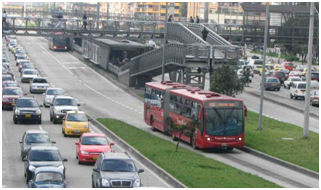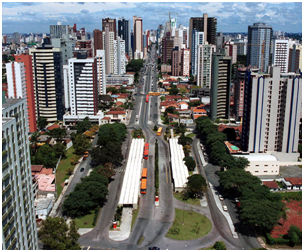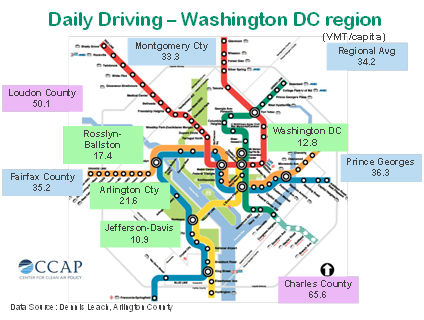Colombia Transit-Oriented Development NAMA Gains High-Level Support
- Steve Winkelman
- May 8, 2013
- 5 min read

Traffic congestion and air pollution in Colombian cities is projected to increase substantially under current trends – CCAP’s recent analysis of a new University of the Andes study, indicates that driving in Colombia is expected to quadruple over the next 30 years. Already a leader in implementing bus rapid transit (BRT), Colombia is ready to take the next step and address land use and urban design tackling traffic and greenhouse gas (GHG) emissions over the long term. CCAP has worked on the ground with leading Colombian stakeholders over the last year to develop a proposal for a Transit-Oriented Development NAMA (Nationally Appropriate Mitigation Action) to implement and finance catalytic transit neighborhoods. Our partners include FINDETER (the national development bank the Colombian ministries of Transportation, Environment, Housing andPlanning,), as well as key local governments (Cali, Bogotá, Barranquilla, Medellín), leading real estate developers, NGOs and university researchers. This effort will link funding for low-income housing from the Ministry of Housing with the Ministry of Transportation’s major investments in BRT and take Findeter‘s Sustainable Cities efforts to a new level and create a new model of urban development for the region and the world.

The Colombian TOD NAMA would transform Colombian cities by focusing urban development around transit stations, blending low-income and market-rate housing with commercial uses to create neighborhoods where people can safely walk, live, work, shop and play. Such “transit-oriented development” (TOD) will enhance the benefits of the major national investment in transit, increasing ridership, financial sustainability and yield a host of economic and social benefits. The NAMA would provide technical and financial assistance on TOD implementation, serve as a policy advisory role in the integration of national policies promoting TOD, and advance national policy goals on transportation, housing, environment, economic development and social equity.

TOD can reduce driving by as much as 50 percent. A range of studies have documented the differences in levels of driving between transit-oriented development and more conventional urban form at the neighborhood, city and regional levels. The Growing Cooler study reviewed empirical measurements and modeling analysis and found that people drive 20-40 percent fewer miles in transit neighborhoods in the US due to increased use of transit, walking and cycling and shorter trip lengths for cars. Data from Washington DC Metropolitan region show that people in transit neighborhoods such as (Arlington Virginia and the Colombia Heights neighborhood of Washington DC) drive 30-70 percent less than the regional average.
Latin American data follows a similar pattern. A 2009 University of the Andes study estimated that a package of transit investment and land use policies could reduce GHG emissions in Bogotá, Colombia by 33 percent compared to the base case. A study of the transit-oriented city of Curitiba, Brazil found that people drive 50 percent less each year than the auto-oriented Brasilia, even though Curitiba has a higher median income. A 2009 IDB study of Curitiba, found that private cars in Curitiba emit 50 percent less CO2 per vehicle than those in Brasilia due to more efficient land use patterns. And transportation GHG targets in major cities in California, informed by sophisticated transportation and land use models and extensive public-input, call for a 15% reduction in per-capita driving which is equivalent to a 34 percent reduction from the baseline forecast.
The TOD NAMA will capitalize on Colombia’s new public-private partnership legislation by providing additional incentives to develop vibrant transit neighborhoods that will enhance economic prosperity, save Colombians time and money on travel, reduce government infrastructure costs, increase returns for real estate and retail, and improve the financial sustainability of transit operators. By changing long-term land use patterns, the TOD NAMA will cut growth in driving by 25 percent, ensuring GHG emission reductions for decades to come. GHG reductions in 2040 are expected to range from 1.9 to 3.8 MMTCO2 per year, depending upon penetration and performance levels.
In November 2012, CCAP hosted a delegation of national and local Colombian officials on a study tour of the Washington DC region to understand how local governments partnered with the private sector (developers and retail) to create dynamic, efficient “transit neighborhoods” with low rates of driving and high quality of life. The Columbia Heights neighborhood was of particular interest to the Colombians with its focus on affordable housing, design improvements for pedestrians and strong engagement with developers and developers to ensure a coordinated transformation to a high-quality neighborhood.
In April, a senior advisor to the President gave their voice of support to the TOD NAMA in a meeting attended by national Ministry Vice Ministers, the President of Findeter, the Colombian Agency for International Cooperation and a senior official from Cali. These officials were excited about the opportunity of the TOD NAMA to synergize national policy efforts and build upon major past and on-going investments in urban transit and low-income housing to support people, protect the environment and bolster the economy.
Next week,the Government of Colombia will present their TOD NAMA proposal at the CCAP Global NAMA Financing Summit in Copenhagen to senior representatives from developing countries and international financial institutions. NAMAs such the TOD NAMA and Colombia’s integrated solid waste NAMA offer an exciting new model for climate finance that are poised to transform the carbon efficiency of key economic sectors while advancing social equity and economic prosperity.
The NAMA would fund the formation of an independent Center for the Promotion of Transit-Oriented Development, staffed by experts in TOD design, evaluation, finance and public-private agreements, who would be supported by technical consultants and guided by an independent technical secretariat. The Center would have two functions:
1. Technical Assistance for Implementing Catalytic Transit Neighborhoods. Initially focusing on approximately five transit districts in Colombia’s largest cities, sample assistance areas include:
Project development. High-quality design, market analysis, project preparation, pre-construction planning
Private-sector partnership. Public-private partnership for RFP development and evaluation, collaboration agreements on TOD implementation
Finance. Developing and packaging funding proposals for domestic and international investors or donors
Value capture mechanisms. Design and structure advanced land-based mechanisms for the investment, operation and maintenance of TOD transit districts, such as Tax Increment Financing and Business Improvement District fees
Replication of policies and plans Continue implementing TOD “pipeline” of sites, districts and corridors
Evaluation. Measuring benefits: greenhouse gas emissions, social and economic (calculation, measurement and data improvement)
2. Policy analysis and guidance to provide the cohesive “glue” to connect national and local policies on transportation, land use and housing with private sector efforts on TOD. For example, providing guidance on TOD public-private partnerships, developing a CONPES document and/or Decree on TOD, integrating national policies and plans with local instruments, and developing a financial sustainability plan.
Colombia led the way on BRT. They are now poised to introduce a 21st century model for urban development to address social equity, climate change and economic prosperity. ¡Vamos!




Comments